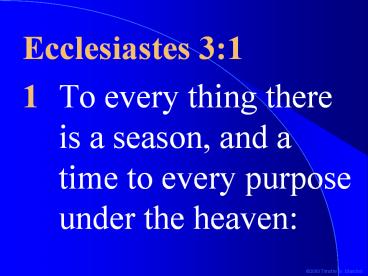Ecclesiastes 3:1 - PowerPoint PPT Presentation
Title: Ecclesiastes 3:1
1
- Ecclesiastes 31
- 1 To every thing there is a season, and a time to
every purpose under the heaven
2
TranscriptionConcentrating on Prokaryotes
- Timothy G. Standish, Ph. D.
3
All Genes Cant be Expressed At The Same Time
- Some gene products are needed by all cells all
the time. These constitutive genes are expressed
by all cells. - Other genes are only needed by certain cells or
at specific times, expression of these inducible
genes is tightly controlled in most cells. - For example, pancreatic b cells make insulin by
expressing the insulin gene. If neurons
expressed insulin, problems would result.
4
Logical Expression Control Points
- DNA packaging
- Transcription
- RNA processing
- mRNA Export
- mRNA masking/unmasking and/or modification
- mRNA degradation
- Translation
- Protein modification
- Protein transport
- Protein degradation
The logical place to control expression is before
the gene is transcribed
5
IntroductionThe Central Dogma of Molecular
Biology
Cell
6
Stages of Transcription
- Transcription can be logically divided into Four
distinct stages - Template recognition
- Initiation
- Elongation
- Termination
- Each stage may participate in regulation, but
template recognition and termination appear to be
major players
7
General Model For Transcription
RNA Polymerase
8
General Model For Transcription
9
General Model For Transcription
10
General Model For Transcription
11
General Model For Transcription
Top- Isomerase I
Gyrase
12
General Model For Transcription
Top- Isomerase I
Gyrase
13
General Model For Transcription
14
General Model For Transcription
15
General Model For Transcription
Ribosome
16
General Model For Transcription
17
General Model For Transcription
18
General Model For Transcription
19
General Model For Transcription
20
RNA Polymerase
- RNA Polymerase is a spectacular enzyme, it
performs the following functions - Recognition of the promoter region
- Melting of DNA (Helicase Topisomerase)
- RNA Priming (Primase)
- RNA Polymerization
- Recognition of terminator sequence
21
Prokaryotic Transcription Initiation
- The ? subunit of prokaryotic RNA polymerase is
necessary for promoter recognition and binding of
RNA polymerase to the promotor - Different ? subunits allow recognition of
different types of promoters thus the type of
genes transcribed can be modulated by altering
the types of ? subunits which attach to RNA
polymerase
22
Prokaryotic Transcription Initiation
RNA Pol.
??
Constitutive Gene
Heat Shock Gene
P1
23
Prokaryotic Transcription Initiation
RNA Pol.
??
Constitutive Gene
Heat Shock Gene
P2
P1
Different promoters
24
Transcription Termination
- There are two types of termination
- Rho dependent requires a protein called Rho, that
binds to and slides along the RNA transcript.
The terminator sequence slows down the elongation
complex, Rho catches up and knocks it off the DNA
- Rho independent termination depends on both
slowing down the elongation complex with a
hairpin and a U rich region that destabilizes the
elongation complex
25
TerminationRho Independent
Terminator
26
TerminationRho Independent
27
TerminationRho Dependent
The terminator sequence slows RNA polymerase
28
TerminationRho Dependent
Rho catches up with RNA polymerase
29
TerminationRho Dependent
The elongation complex disintegrates
30
(No Transcript)
31
Transcription
Coding (sense) strand
3
5
5
3
Template (antisense) strand
32
Transcription
33
Transcription
Coding (sense) strand
3
5
5
3
Template (antisense) strand
5
34
Products of Transcription
- Transcription produces three major RNA products
- 1 Ribosomal RNA (rRNA) - Several rRNAs are vital
constituents of ribosomes - 2 Transfer RNA (tRNA) - The molecule that
physically couples nucleic acid codons with
specific amino acids - 3 Messenger RNA (mRNA) - The nucleic acid
messenger that carries encoded information from
genes on DNA to the protein manufacturing
ribosomes
35
Transfer RNA (tRNA)
- Acts as the adapter molecule between the genetic
code on mRNA and the protein language - 75-85 bases long
- A specific amino acid is covalently linked at the
3 end - Elsewhere on the molecule is an anticodon
complimentary to the specific amino acid codon on
mRNA that codes for the amino acid carried by the
tRNA - Contain a number of modified bases
36
A Simple Gene
Transcription Start Site
3 Untranslated Region
5 Untranslated Region
Protein Coding Region
3
5
RNA Transcript
Terminator Sequence
Promoter/ Control Region
37
Transcription Initiation
- Proteins called transcription factors bind to the
promoter region of a gene - If the appropriate transcription factors are
present, RNA polymerase binds to form an
initiation complex - RNA polymerase melts the DNA at the transcription
start site - Polymerization of RNA begins
38
Initiation
T. F.
39
Transcription And Translation In Prokaryotes
40
Heat Shock Response Elements
- Sudden changes in the temperature of cells cause
stress in response to which heat shock genes are
expressed - At least some heat shock genes are thought to be
chaperones that help proteins fold correctly - Heat shock genes have Heat Shock Elements (HSEs)
in their control regions - Heat Shock Transcription Factors (HSTFs) bind the
HSEs up regulating expression of heat shock gene
products
41
(No Transcript)
42
Control of Gene Expression
Packaging
Transportation
43
A Simple Gene
44
Initiation
T. F.
45
Transcription And Translation In Prokaryotes































